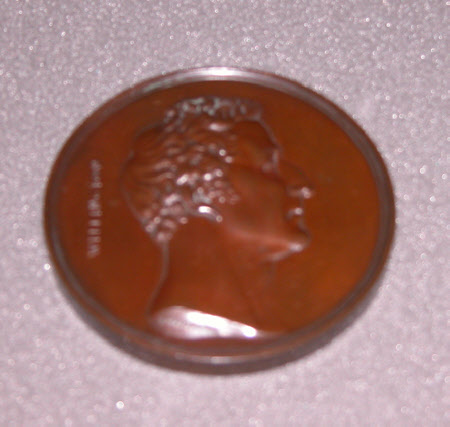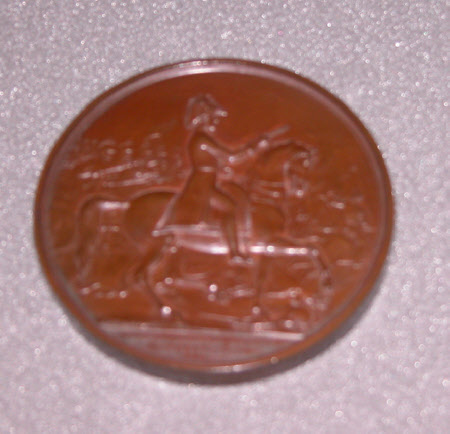The Duke of Wellington as Commander-in-Chief of the British Army
John Henning the Elder (1771-1851)
Category
Coins and medals
Date
1827
Materials
Bronze
Measurements
625 mm (Diameter)
Place of origin
London
Order this imageCollection
Anglesey Abbey, Cambridgeshire
NT 517316
Summary
Bronze, portrait medal, Arthur Wellesley, 1st Duke of Wellington (1769-1852), by John Henning the Elder (1771-1851) and John Henning the Younger (1802-1857), published 1827 by S. Parker, London, to celebrate the appointment of the Duke as Commander-in-Chief of the British Army. The obverse of the medal has a profile portrait of the Duke based on a drawing made by Henning in 1812, for use in Wedgwood medallions. The reverse, designed by John Henning the Younger, shows the Duke as a Commander on horseback, advancing right, baton in raised right hand. Behind him ranks of cavalry, which gallop into action at the right. Sunburst at upper right.
Full description
More than 200 medals have been issued celebrating and commemorating the life and achievements of Arthur Wellesley, First Duke of Wellington (1769-1852), the Anglo-Irish soldier and statesman who won lasting fame thanks to his victories over the forces of Napoleon Buonaparte, firstly in the Peninsular War in Portugal and Spain (1807-14) and then at the Battle of Waterloo in 1815, and who would subsequently serve twice as Prime Minister. A national hero following Waterloo, Wellington was appointed Commander-in-Chief of the British Army on 22 January 1827. The medal by the Hennings father and son celebrates this appointment, which the Duke had to give up when he became Prime Minister in 1828. The finished medal was exhibited on both sides at the Royal Academy exhibition of 1828 (nos. 492-93). The obverse, with its strongly neo-classical profile portrait of the Duke, is based on a portrait sketch of the Duke by John Henning the Elder, dated 6 March 1827 (illustrated Eimer 1994, p. 59). The reverse, with its scene of cavalry advancing into battle, may have originally been designed for a medal commemorating the Battle of Waterloo, which does not appear to survive. It has been claimed that the design was made by the younger John Henning when he was just thirteen years old. Jeremy Warren, 2018
Provenance
Bequeathed to the National Trust by Huttleston Rogers Broughton, 1st Lord Fairhaven (1896-1966) with the house and the rest of the contents.
Credit line
Anglesey Abbey, The Fairhaven Collection (The National Trust)
Marks and inscriptions
Obverse, in field: WELLINGTON. Obverse, on truncation: J. HENNING Reverse, on baseline: J. Henning Junr Reverse, in exergue : PUBD. BY S. PARKER LONDON/MDCCCXXVII.
Makers and roles
John Henning the Elder (1771-1851), sculptor John Henning the Younger (1802-1857) , sculptor
References
Malden 1977: John Malden, John Henning 1771-1851, “… a very ingenious Modeller…”, Paisley 1977, unpaginated Eimer 1994: Christopher Eimer, Medallic Portraits of the Duke of Wellington, London 1994, pp. 58-60, no. 101 Brown 1980: Laurence Brown, British Historical Medals. I. 1760-1837, London 1980, p. 320, no. 1313 Eimer 2010: Christopher Eimer, British Commemorative Medals and their Values, London 2010, p. 166, no. 1191, Pl. 130 Wall 2008: John Wall, “That Most Ingenious Modeller”. The Life and Work of John Henning, Sculptor 1771-1851, Ely 2008, pp. 96, 98

